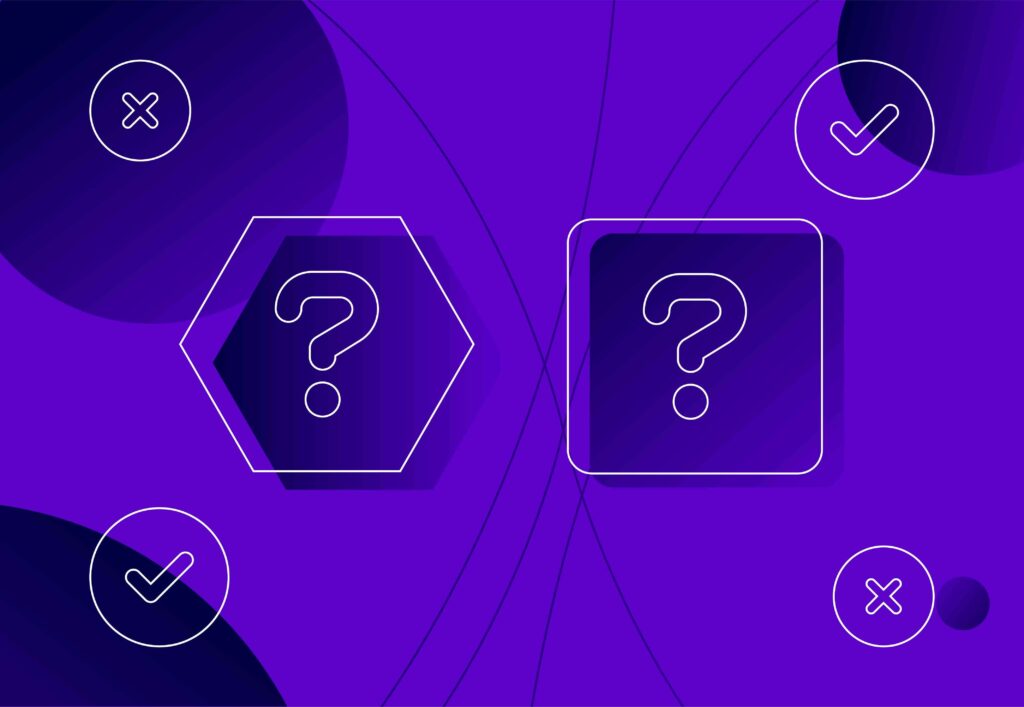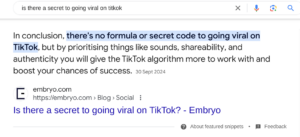
Tips for using open-ended and closed questions

Using questions in your content is a great way to get your audience engaging with your website, allowing you to really understand what your audience is looking for, and understand their pain points.
There are different ways you can use questions in your content depending on what you want your user to think. A good example of this is using open-ended questions and closed questions.
In this blog, we are going to look at what open and closed questions are, the type of intent they match, and where to use them to get the most from your content.
First, let’s summarise the basics, and look at the difference between open-ended and closed questions.
What is the difference between open-ended and closed questions?
Closed questions can only be answered from a limited number of responses. This could be a ‘Yes/No’ question, or a question based on a scale from strongly agree to strongly disagree. With closed questions, users can give a very quick response, without the need to elaborate or explain with reasoning.
Open-ended questions require a bit more effort from the person answering, making them think about the reasoning for their answer. These questions are usually trying to get an opinion-based or experience-based response from the user.
For example, if you were to carry out a survey about customer experience on your website, the questions might include:
| Closed questions | Open-ended questions |
| Would you recommend our business to a friend? | Why would you recommend our business to a friend? |
| Would you shop with us again? | Why did you enjoy/dislike your shopping experience? |
| Were you happy with your shopping experience? | How would you describe your experience with our brand? |
Closed questions are good for gathering quantifiable data. This means that the answers and data you collect from closed questions are good for quick analysis and looking at trends. Due to the short nature of the response, there are fewer answer options, allowing you to group respondents into categories.
Due to the longer responses that open-ended questions require, analysis of answers can take longer. The range of answers means that themes and patterns can take longer to identify.
Why should I be asking questions on my website?

While the above example uses a survey, where you want responses to questions not all questions on your website are there to be answered (rhetorical).
You may want to include questions to emphasise a specific point, or to use humour and sarcasm to get the reader involved. Questions are also a great way to get the reader subconsciously answering in their head, getting them involved with the content and directly addressing their problems.
From an SEO perspective, most things typed into Google are queries, in other words, a question. So why would you not use these questions and try to provide the user with a solution?
Let’s take a look at some of our top tips for when to use open and closed questions on your website.
Top tips for when to use open-ended questions

As page titles
As already mentioned, Google Search is there for people with questions. Hence, you should be creating content to help answer those questions. If the title is worded as a question, and the user is looking for the answer, they are highly likely to click on this page. For example, ‘Why do I need to analyse my website data?’ is an open-ended question
Using questions as page titles is also great for attracting search users who are researching a topic, not necessarily looking to convert. It grabs attention quickly, especially if someone feels like they don’t know the answer and wants to get to know.
As headings
Breaking down your content into sub-topics is a great way to simplify an information-based piece of writing for the reader. Especially for long-form content, having your headings as questions will allow the user to pinpoint which section is most relevant to them. These questions are also likely to be written in the first person, allowing the reader to immerse themselves in the content. In this very blog, we have used an open-ended question as the first heading ‘What is the difference between open-ended and closed questions?
Prompts for reviews
If you are looking for testimonials or reviews on your website, closed questions won’t give the detailed responses you are looking for. You want to be able to showcase the nitty-gritty reasons of why people love your brand and what you do. It’s great if this type of feedback is generated organically, but there’s nothing wrong with having to politely nudge or ask for structured feedback. Questions like ‘What makes our brand different to others in the same field you have worked with previously’ are sure to get a shining testimonial to feature on your website.
Top tips for when to use closed questions

At the end of content
If the reader has gotten to the end of a piece of content on your website, it is highly likely that they found it useful and it matched their intent. Why not try and steer them towards other helpful blog posts? Or maybe a related video tutorial on your site? Ending your content with a question in the summary is a great way to get the reader wanting to take an action, while they are already engaged. An example could be ‘want to read more content like this?’. Follow this with an immediate solution by linking to something useful and related to the topic.
Questions at the end of informational content are also a good opportunity to offer up your expertise and encourage the reader to get in touch: ‘Need some expert advice? Get in touch today’. By placing this question at the end of the content, you are implying to the reader that their problems are unique, and can’t be answered in general website content.
In persuasive content
Yes, questions should get the reader to think broadly, and get them engaged and involved in the content. But sometimes you may want to sway a reader to think a certain way. Closed questions can be a great way to get the reader to quickly agree or disagree with your statements. This can be done by using an informal and conversational tone. For a home and garden website, this could be questions like: ‘We all know sage green is the latest trend for living room decor, don’t we?’.
In lead-gen forms
As we know, getting the user to the point of filling in a form on your website is what all the hard work of website content is for. But do you really want to scare them away with multiple open-ended questions? Don’t create barriers to conversion- keep the form as simple as possible by using short closed questions when they are needed.
Post-conversion
‘How would you rate your experience today?’ is a simple way to get a user to respond without a great length of detail. Using star ratings, a scale from 1-10 or even smiley face ratings are examples of closed answers.
Close the door on dull questions
Make the most of your questions by knowing what to ask and when to ask it. Keep your readers engaged by understanding the intent and matching questions towards this.
Read our other blogs for top tips on your website content writing.



